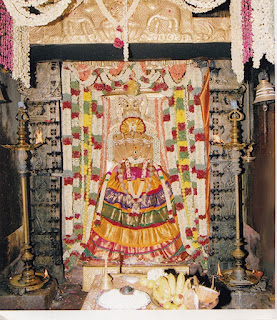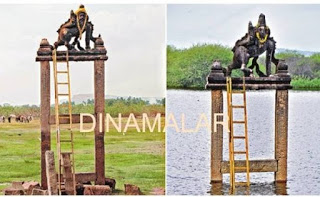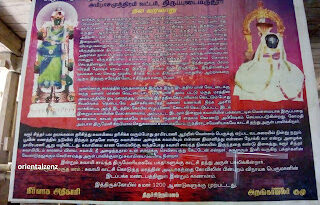Nerur Sadasiva Brahmendra Swami Biography – Miracles and Samadhi – 2
Read Part-1 https://www.orientalzenz.com/nerur-sadasiva-brahmendra-the-early-life-and-enlightenment/
Miracles
He is said to have performed many miracles whilst alive, some of the most prominent are provided below.
1) On the river banks of Cauvery in Mahadhanapuram, he was asked by some children to be taken to Madurai, more than 100 miles away, for an annual Rishabavahana festival in Meenakshi temple. The saint asked them to close their eyes, and a few seconds later they reopened their eyes and found they were in Madurai.
2) While relaxing near a heap of grains, he began meditating. The farmer who owned the land mistook Sadasiva for a thief, and confronted him. The farmer raised his stick to hit the saint, but became a statue. He remained in this state until the morning, when Sadasiva finished meditating and smiled at the farmer. The farmer was restored to his normal state, and asked the saint for forgiveness.
3) At another time, while meditating on the banks of the Cauvery river, he was carried away by a sudden flood. Weeks later, when some villagers were digging near a mound of earth, their shovels struck his body. He woke up and walked away.
4) Maharaja Vijaya Ragunatha Thondaiman, the then ruler (1730-68) hearing about the greatness of the saint , rushed to bring Sri Brahmendra to the palace to be honoured. Brahmendra did not break his silence.The ruler pitched a camp in Tiruvarankulam and served the sage. Brahmendra answered his prayer by writing Sri Dakshinamoorthi Mantra on sand(1738 AD). He also instructed the king to appoint Sri “Mahabashyam” Gopalakrishna Shastri of Bhikshandar Koil as a minister in his palace. Ragunatha Thondaiman gathered the sand in his angavastram and took it to his palace. The place where this happened is called Sivagnanapuram, which still exists near Avudayar Koil in Pudukottai district.This sand was picked up by the king and it is in the worship of the royal family till now in the Dakshinamoorthy temple inside the Pudukottai palace in Pudukottai.This temple is opened to Public only on Thursdays.

Gopalakrishna Sastri was a great scholar in Sanskrit grammar and became the palace guru at Pudukkottai due to Sadasiva‟s wishes. Sastri descendants continued to be the Palace Gurus until 1947.Sastri himself became a recluse in his old age and his Samadhi is in Namanasamudram near Pudukkottai.Sastri is well-known for his work called Sabthika Chinthamani , a commentary on Panini’s Ashtadhyai.

5) Long after all these happened when almost people had forgotten the memories of his wandering in their lands, once the naked sannyasi was seen walking right through a Muslim harem of a Nawab. As a brahma-jnani who sees nothing but brahman everywhere, he would not distinguish between the different human figures which cross his path nor would he be distracted by the sights or noises that his environment may present to him. It was in this state of trance that he was walking along. He, the naked sannyasi, walked straight into the harem, entering it at one end and walking out at the other all the while walking through a maze of inmates of the Nawab’s harem. The news reached the nawab, he had his men chase him, they cut off both his hands as he was walking along, the hands fell off and still he was walking along silently as if nothing had happened. The Nawab got scared, picked up the hands that had been severed, ran to the Sage and offered them in total remorse. The sage stopped his walking, the severed hands were restored to their place, the hands became normal and the sage walked away! There was no conversation. This nawab was probably Chanda Saheb.
6) In 1732, While SadaShiva Brahmendra was roaming near Pudukottai forests some soldiers saw him & mistakenly asked him to carry some sticks on his head. SadaShiva Brahmendra carried happily & when he kept that sticks in kitchen ground, it burnt. Then those soldiers understood that he was an great Saint.
7) There was a uneducated & born dumb man who was a devotee of SadaShiva Brahmendra. He served the Guru immensely. One day, SadaShiva Brahmendra kept their hand on his head & prayed to Lord to give him speech and knowledge. By the grace of SadaShiva Brahmendra that dumb man became educated & he started to talk. He started giving speeches & he was famous as “Akasha Purana Ramalinga Shastry”. Up to this 20th century, Ramalinga Shastry’s relatives were staying in Nerur. This incident is also mentioned in the Sri SadaShivendra Sthava ( Verses 22 & 26).
Temples
1) He used to frequently meditate in the Tirugokarnar Shiva temple in Pudukottai near the Goddess Brahadambal shrine. The place he used meditate can be still seen today. A saintly figure, beardless and wearing a small loin cloth around the hip is seen on one of the pillars of śukravāra maṇḍapa of this temple . He stands in añjali posture. He has long ears without ornaments. He has shaven face and tonsured head with a topknot. One rudraksha mala is seen around his neck.

2) He was responsible for installing the deity Punnainallur Mariamman near Thanjavur. The temple has a stucco image of Sadāśiva Brahmendra on the left side of the gopura. The Maratha king Tuljaji is presented on the right side of the same gopura. Sadāśiva Brahmendra stand with Vibhūti is pasted on his forehead, chest, belly and arms. He has chinmudra and has completely shaven the face and head. The king is standing in the añjali pose.
3) He guided the installation at Devadanapatti Kamakshi temple, near Theni, TamilNadu.

The above two incidents are depicted in a Tamil movie by name “Maha Shakti Mariamman”
4)He also installed the Hanuman Murthi in the Prasanna Venkateswara temple at Nalu Kal Mandapam in Thanjavur.
5) He also installed Lord Ganesh and a powerful Ganesh Yantra at the Thirunageshwaram Rahu Stalam temple at Kumbakonam.An inscription in the temple bears testimony to this fact. The shrine can still be seen at the entrance to the temple.
6) He installed the Jana Akarshana Yantra at Tantondrimalai Srinivasa Perumal temple, near Karur. This shrine is visited by all devotees in this area who are not able to a pay a pilgrimage to Tirupathi.
7) He also installed the Sri Chakra in the shrine of Siruvachoor Madurakali temple near Perambalur.
8) There are numerous temples were he has installed a deity. It is said Gunaseelam temple is also installed by him.
9) There is a shrine of Sri Sadasivendral in the Nandru Udaiyan Ganapathy temple in Trichy.
10) Parshvanayaki Sametha Sri Agnishwarar Temple at Trichy was also established by Brahmendral who stayed there for few years (Incidentally, the Shiva temple at Nerur is also called as Agniswarar)
Samadhi
Later he left Tiruvisanallur and reached Nerur, the surroundings of which were conducive and ideal for stay and penance with the river flowing southwards. A place where river flows southwards, is considered equal to Kashi ( Banaras).
Sri Sadasiva Brahmendra attained Maha Samaadhi on the Vaisakha Sukla Dasami with Makha star in the year 1755 A.D. Before his Samadhi,he mentioned that a Bilva tree would come over his Samadhi. He also mentioned that after 10 days, someone would bring a Shiva Linga and it has to be installed at a particular distance from his samadhi. Needless to say, it happened the same way.
Sri Sadasiva Brahmendra attained Mahasamadhi at 5 places corresponding each of the 5 elements – Panchabhutas near 5 rivers.
- Nerur(TamilNadu) – On the banks of Kaveri
- Manamadurai about 60 km from Madurai – On the banks of Vaigai
- Karachi, now in pakistan – On banks of Sindhu
- Kashi – On the banks of Ganga
- Puri or Omkareshwar – There are different versions on this.
His Jiva samadhi site is briefly mentioned in ‘Autobiography of a Yogi’ by Paramahamsa Yogananda (Chapter-41).Every year in Nerur and Manamadurai, music festivals are conducted in his honor. In Manamadurai, his samadhi is located at the Sri Somanathar temple, which was identified by the Paramacharya of Kanchi. In the year 1912, a sanyasin “Laksharchanai Swamigal” started the Aradhana for Sri Brahmendral at Nerur and it has been continuing since then.

Sivan Sir on Sadasiva Brahmendra
Sivan Sir or Sri Sadasiva Shastrigal has written a magnum opus on Hindu Dharma by name “Yenipadigalil Manthargal” (Tamil).
He also mentions that Sri Brahmendral blessed two Muslim brothers(Irratai Mastan) with divine knowledge. Their Samadhi (Dhargah) is located in Gandhiji Road in Thanjavur.

Slokas on Sadasiva Brahmendra
Sri Sri Sacchidananda Shivabhinava Nrusimha Bharati, pontiff of the Sringeri Saradha Peetham had visited Nerur and composed two slokas in praise of Sri Sadasiva Bramhendra – Sadasivendra Stava and Sadasivendra Pancharatna. Another Saint, Balasubramanya Yatindra has written Sadasiva Stotra.
It is interesting to note how the Sringeri Acharya came to Nerur. The acharyal was staying in Ranganathapuram in Karur( sometime during 1908-1910). When he commenced his journey from this place, the palanquin bearers had a difficulty in carrying him. When he enquired with them, they told that they were pushed by an invisible force. The acharyal then got down and meditated for sometime.Then he started walking in the direction of the force for around 3 kms. He ended up in the Adhistanam of Sri Brahmendral.
The acharyal then stayed there for 3 days, did intense penance without food or water. At the end of 3 days, people could hear someone talking to the acharyal but were unable to see the person. Acaryal was having the physical darshan of Sri Sadasiva Brahmendral. He then spontaneously composed the two hymns on Sri Brahmendral – Sadasivendra Stava and Sadasivendra Pancharatna.
Tembe Swami or Sri Vasudevanand Sarasvati of Maharashtra had high regard for Brahmendral. The reference below is taken from his autobiography in Marathi – “In Saka (or Salivahana era) 1829, CE in 1907, Kartik month, Shri Tembe Swami left the village named Bhavani and reached Nerur, a village close to Karur railway station. There is a Jeeva samadhi of the great saint Shri Sadasiva Brahmendra Swami in this village. Sadasiva Brahmendral swami had done upasana of Nagna Dattatreya and he was a great mahatma. He had transcended the sixth stage of ‘Parato Vyutham’ of a jnani. Shri Brahmendral had written “Brahmasutra Vruthi” and “Yogasudakaram”. His incredible powers and his very high spiritual stage is described in the preface of these books. Every seeker should read these books for spiritual progress. Shri Tembe Swami Maharaj had himself made a handwritten copy of Shri Brahmendral’s “Brahmasutra Vrutti”. Shri Tembe Swami used to tie his handwritten copy, along with the copies of Shri Brahmendral’s stotras and his advice, to his waist during his travel. From this it is clear how much shri Tembe Swami Maharaj revered Shri Brahmendral and his works and spent time reading and contemplating on ‘Brahmasutra Vrutti’. Shri Tembe Swami Maharaj has also written a stotra in praise of Shri Brahmendral.”
Spiritual Works
He is the author of several works:
- Brahma tatva prakashika – Vritti (Commentary) on the Bramha Sutras
- Yoga Sudhakara – Commentary on the Yoga Sutras of Patanjali
Sri R.M.Umesh has written an English translation of this book with the name “Science of Mind Control”. This book was published by the Sringeri Mutt.
- Nava Mani Mala – He composed this work in honor of his Guru Sri Paramsivendra Sarasvati
- Atma Vidhya Vilasa is a poetic work running into 62 verses in simple, lucid language on the core subject of renunciation.
- Siddhanta Kalpavalli with Kesaravalli – This explains the Adavita philosophy as described by various saints over a period of time. Appaya Dikshitar wrote Siddhanta -lesa-Sangraha which was a detailed exposition of the advaita doctrine. Brahmendral simplified it and wrote Siddhanta Kalpavalli with 212 verses. Sri Vasudeva Brahmendra, disciple of Upanishad Yogin wrote a commentary on the above.
- Advaita Rasa Manjari
- Shiva Manasa Pooja
- Dakshinamurthy Dhyanam
- Navavarna Ratna Mala -This stotra praises Shri Dakshinamurti as the one and only cause of the entire world. He is shown as saguna but in fact nirguna.
- Mano Niyamana – Composition addressing the Mind to turn inward and focus on God
- Shiva yoga Dipika or Shiva Yoga Pradeepika
- Paramahamsa Charya – This book describes the code of conduct for Paramahamsa Sanyasis
- Advaita Taravali – This advaitic work contains 27 verses like the 27 stars in Hindu Calendar
- Swapnoditam -This contains a description of the Jivan Mukta state
- Svanubhuti Prakashika- In this work shri sadashiva expresses his own Jivan Mukta experience in his own words
- Atma anusandhana – Shri Paramashivendra Saraswati has written a most excellent Vedanta work called Vedanta Nama Ratna Sahasram in which He has collected from the Upanishad-s a thousand names of the para Brahman. Normally only deities like shiva, Vishnu with name and form have sahasranama-s, but here shri paramashivendra has collected the same for Para brahman Itself. From that, Shri Brahmendra has collected above two hundred names and identified Himself with that Brahman in this work.
- Suta Samhita Sarasamgraha
- Commentary on Sri Sankara’s Maya Pancaka called Tatparya Deepika
Unpublished Works
- Dwadasa Upanishad Vyakhyana Dipika
- Kaivalyopanisad Dipika – A Commentary on Kaivalya Upanishad
- Commentary on Amrita Bindu Upanishad
- Saparya Paryaya Stavah – Sri Brahmendra mentions his state and that he is not able to do regular physical puja.In this composition he talks about God’s formless nature.
- Atma-Anatma Viveka Samgraha
- Advaitanusamdhana
- Sarva Vedanta Sara Samgraha
- Brahmamrutavarshini
- Maha vakyartha sadhana
- Bodharya Prakarana
- Gita ratnamala – A Commentary on Bhagavat Gita
- Ratna Didhiti
- Karikas on Sankara’s Atma Panchaka
- Tattvaprakasika
- Bhagavata sangraha
Contribution to Carnatic Music
He also wrote several Carnatic compositions to spread the advaita philosophy among common people. His compositions are quite popular and can be heard frequently in Carnatic concerts. Some of these are
1.Ananda Purna Bodhoham Sachchidananda-Shankarabharanam
2.Ananda Purna Bodhoham Satatam – Madhyamavathi
3.Bhajare Gopalam – Hindolam
4.Bhajare Raghuviram – Kalyani
5.Bhajare Yadunatham – Peelu
6. Brahmaivaham – Nadanamakriya
7.Bruhi Mukundethi -Gowla,Navaroju,Kurinji,Senchurutti
8.Chetah Sreeramam – Dwijavanthi,Surathi
9.Chinta Nasti Kila -Navroj
10.Gayathi Vanamali-Gavathi,Yamuna Kalyani
11.Khelathi Brahmande-Sindhubhairavi
12.Khelathi Mama Hrudaye – Atana
13.Kridathi Vanamali – Sindhubhairavi
14.Krishna Paahi – Madhyamavathi
15.Manasa Sanchara Re – Sama
16.Nahi Re Nahi Re – Gavathi
17.Pibare Rama Rasam- Ahi Bhairavi
18.Poorna Bodhoham- Kalyani
19.Prativaram Varam- Thodi
20.Sarvam Bramha Mayam – Mishra Sivaranjani
21.Smaravaram – Jog
22.Sthiratha Nahi Nahire – Amruthavarshini
23.Tatvat Jeevitham – Kiravani
24.Tunga Tarange Gange – Hamsadwani
References
- Chapter on Sri Brahmendral by Sri Sivan Sir in his book “Yenipadigalil Manthargal”
- Tamil writer Balakumaran has written a novel Thozhan based on the life of Sri Sadasiva Brahmendrar.
- Nerur Sadasiva Brahmendra Sabha has published a book “Sri Sadasiva Brahmendra: His Life, Extracted Teaching and Reflections” by Sri T.P. Vinayaka Rao
- Saints and kings from the Kaveri belt of Tamilnadu by Sri. V. Gopalakrishnan
- Sri M mentions in his Autobiography about his links with Brahmendral from a previous birth
Other Books on Brahmendral
B.V. Kamesvara Aiyar, “The life and teachings of Sadasiva Brahma”, 1899
N.K. Iyer, “Sri Sadasiva Brahma”, 1955
Adidevananda, “Sri Sadasivendra Sarasvati”, 1964
Suddhananda Bharati, “Sri Sadasiva Brahman”, 1972
N. Raghunathan, “Sadasiva Brahmendra Sarasvati”
T.R. Rajagopala Iyer, “Kirtanas of Sadasiva Brahmendra”, 1981
Vedakavi, “Kirtanas of Sadasiva Brahman”, 1981
V.S. Guruswamy Sastrigal, “Sri Sadasivendra Sarasvati”
Prema Nandakumara, Sri Sadasiva Brahmenda , 1993
Prema Nandakumar, “Sadasiva Brahmendra’s Bhakti Yoga”, 2004
Laghuprakarana: Minor Works of Sadasiva Brahmendra Sarasvati. Edited by K. Kamala and V. Srinivasa Sarma. Hyderabad 2007
P.R.Kannan, “Shri Sadasiva Brahmendra: poet, philosopher, and mystic”, 2008
P.R. Kannan, “Sadasiva Brahmendra, the siddha purusa”, 2008
P.R. Kannan, “Reflections on Brahmendra’s Kitanas’, 2008
Birth details of Sri Sadasivendral
Birth Details of Sadasiva Brahmendra ( From internet sources)
13-04-1670 06:09 IST Madurai. Sivaramakrishnan
Sadarana Chithirai Krishna Ashtami. Sunday. Sravan – 1 pada
Sun – 4 37 12. Moon 280 35 35 Mars – 249 50 13 Merc- 337 26 Jup -79 10 37
Venus – 17 41 33 Sat 314 44 Rahu 2 48 39 Ketu 182 48 39 Lagna 207 46 56



